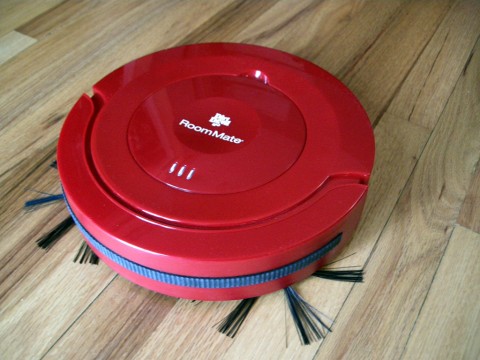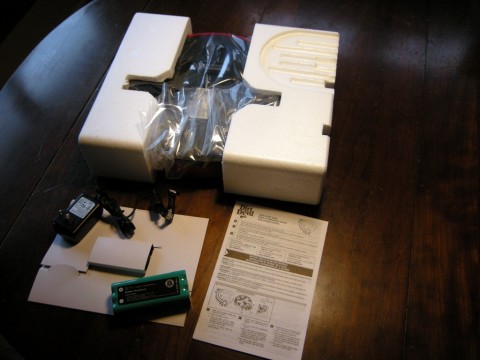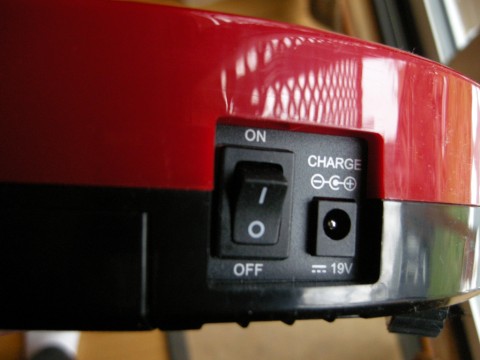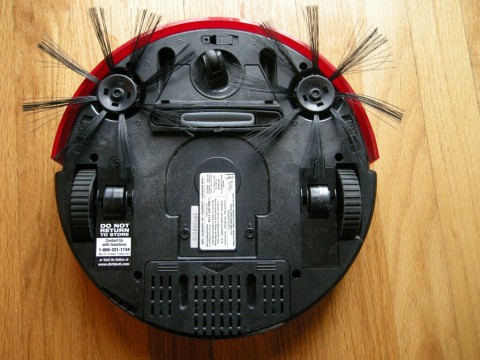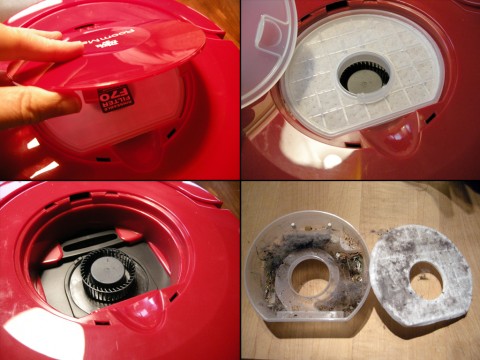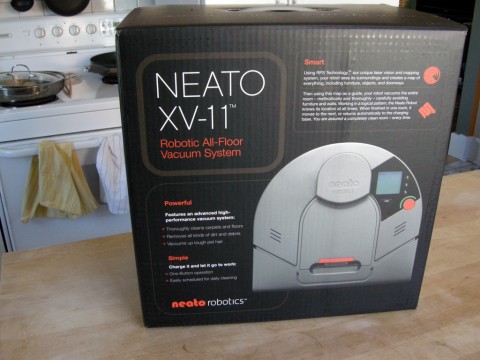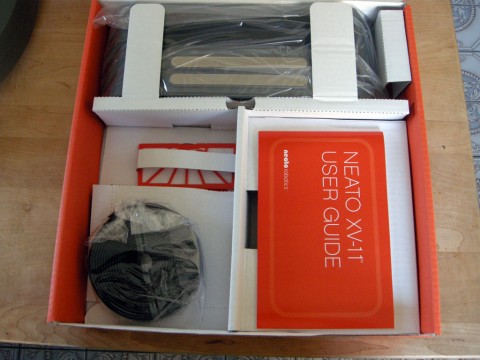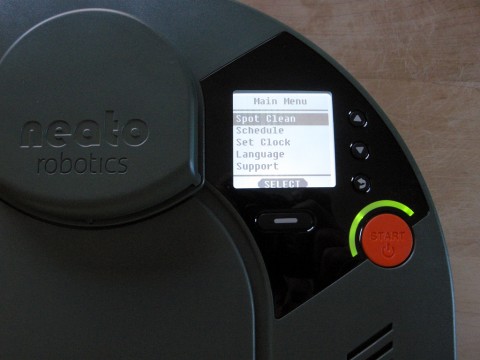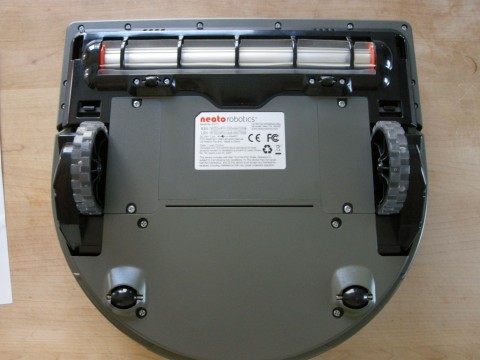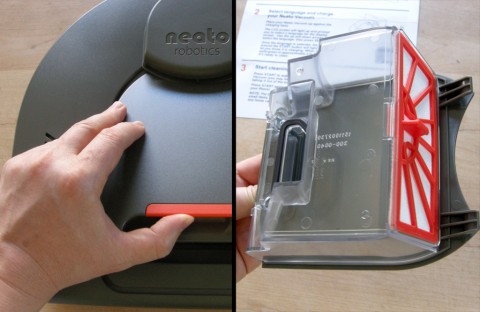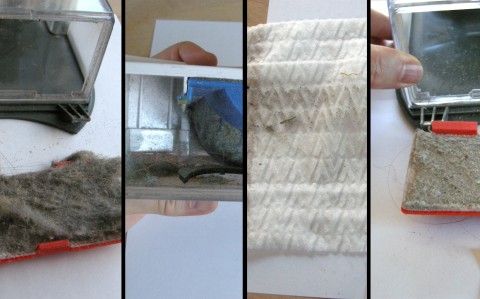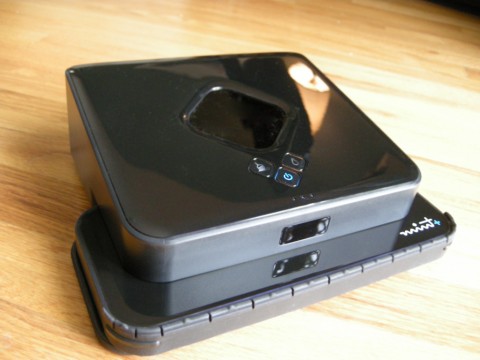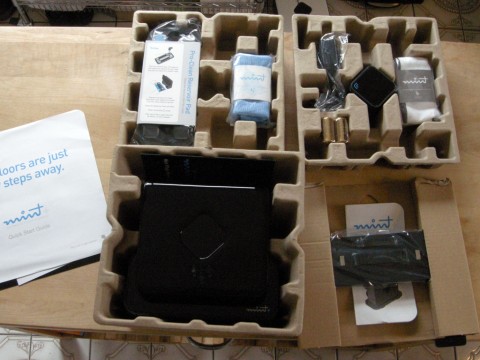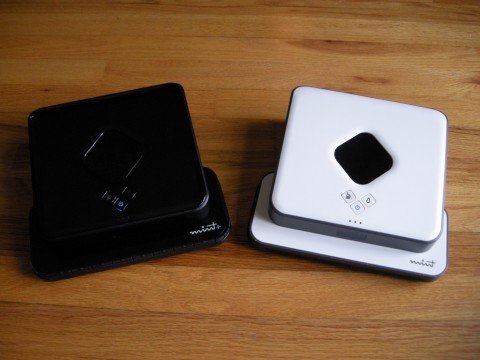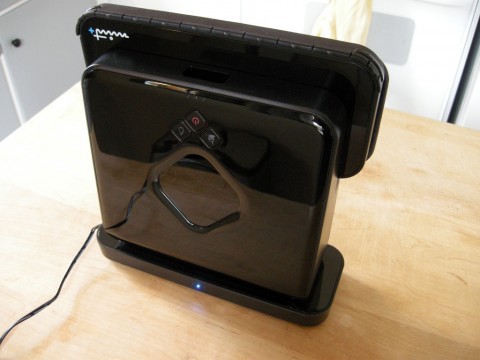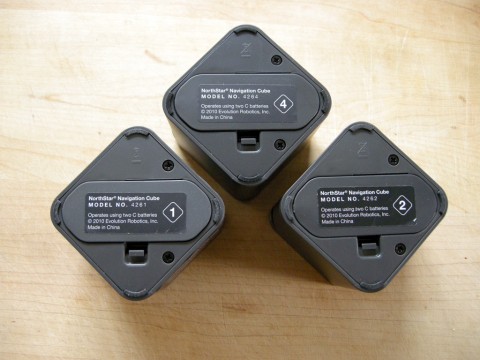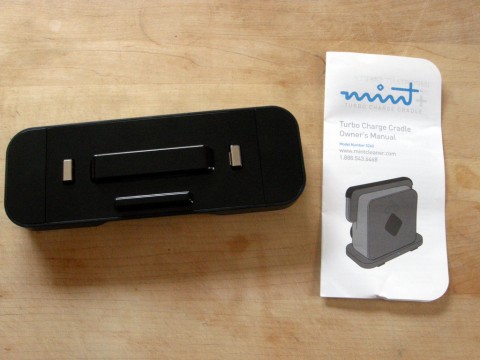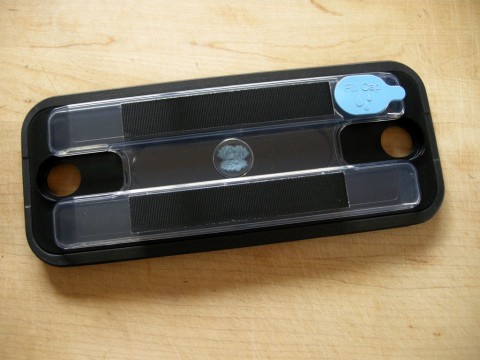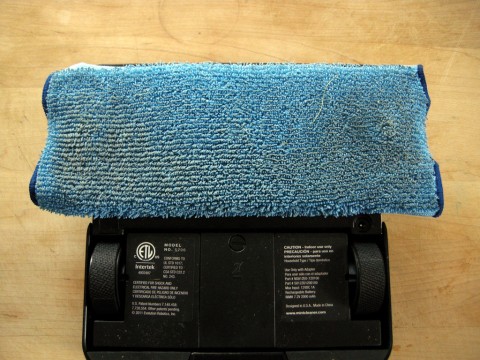What we have here is a hard floor cleaning robotic vacuum cleaner that is something of a Roomba look-alike. It’s a vacuum with dual side-brushes, and like a Roomba it does a random behavioral kind of cleaning (as opposed to mapping out a room like the Neato XV-11 and Mint Cleaners do). Here’s one that appeared in 2011 without a bang: The Dirt Devil RoomMate Robotic Vacuum Cleaner by Royal Appliance Mfg Co. The best I can figure out, this item was introduced in April or May of this year, with little or no fanfare. There aren’t any reviews on the Amazon product page yet, even. So I’m pretty sure that this is the first review for this item.
The robot comes with everything you need to get started in the box: The robot itself, 2 detachable side bristle brushes, a manual, a quick-start guide, the battery, and battery charger. . The battery is a 14.4 Volt, 800mAh NiMH unit that looks like it’s made of 12 AA cells wrapped up into a single module. The quick-start guide gets you through attaching the side brushes, inserting the battery, and operating the robot for the first time. The manual is one of those frustrating affairs because it is written in three languages and they’re all crammed together. So each page has every step and illustration detailed in English, Spanish, and French together. I don’t know why it is, but I always find myself trying to read the French sections.
The robot takes four hours to charge. A charge lasts over an hour with a new battery. The manufacturer says that the robot should last 50 minutes. Ours lasted about one hour, ten minutes for our testing. On the top of the robot there are three LED lights. They are: “Battery Low” indicator, “Dirt Cup Full” or “Clog” indicator, and “Charging” indicator. To be honest, the outside two lights flash while the robot is cleaning, so I haven’t really been able to figure out what they mean.
Here is the robot in action:
As you can see, it does random criss-crossing of the room, followed by circling/spiraling and then it does wall following. It actually does those things in that order. It follows walls in one direction only, going clockwise around a room perimeter when viewed from above. Also like the Roomba, Mint Cleaner, and XV-11, the Dirt Devil has a bumper in front to tell when it has run into something. The Dirt Devil also seems to use that bumper to do its edge following. Like other floor cleaning robots, the Dirt Devil has cliff sensors to keep it from going off an edge.
Despite its appearances, the Dirt Devil is different from a Roomba in quite a few ways. For one thing, it lacks a lot of the advanced features built into Roombas these days. There’s no Dirt Detect, no dock, no Lighthouses, no scheduling, no remote control, and etc. As you can see, the robot is smaller than a Roomba, and shorter. You put the robot in a room, switch it on, and the robot is done when the battery runs out. When it’s done it gives a distintive chirping noise. Since the robot vacuums until the battery is gone, you need to charge it again before you can do another room.
Looking at the bottom of the robot reveals even more differences from a Roomba. The Dirt Devil has two side brushes instead of one. Unlike a Roomba or XV-11, there are no beaters or intake brushes. Instead, the side brushes direct dirt and debris into a mouth-like intake where the vacuum sucks it into the filter cup. So on the plus side, it won’t inhale power cords. During testing, however, the robot had some trouble with the intake getting clogged by large dust bunnies. When I looked at the dust bin, I noticed that there’s a cellophane lid that is made to keep debris from falling back out of the bin. I bet if a person pulled that out, it might not have such a hard time with the dust bunnies.
The robot moves more slowly than any other robot vacuum we’ve reviewed here, and as a result it’s more gentle when it runs into furniture, doors, and walls. It’s more noisy than the Mint, but definitely more quiet than a Roomba. During testing the robot didn’t have any problems moving around rooms, but it did have some trouble with floor mats and area rugs. In particular, depending on its angle of approach, the robot sometimes got stuck trying to climb up area rugs and floor mats. Like every other robot floor cleaner in the world, when left unattended, this robot may get stuck in unexpected places and can get tangled in cords.
The filter cup is easy to get to and very easy to empty. One nice thing is that the cup and filter can be cleaned with water, although obviously they need to be dried properly before putting them back in the robot.
So how does it do? As the title states, it does the job. I was able to use it to clean several rooms, and was satisfied with the results. I did my standard test where I ran other robots after the Dirt Devil cleaned a room to see how it did, and in all cases it didn’t leave much for the other robots to clean up on hard floors. Although it is a vacuum cleaner, it’s not designed to clean carpets. I’m guessing that this is because the robot lacks beaters and intake brushes to pull dust and dirt out of carpets. One thing we were impressed by was its ability to suck up larger debris like pine needles from our Christmas decorations.
Pros
More sensitive bumper than most other robots.
Won’t eat cables and cords (although it can still get stuck on them).
Less room prep work needed.
Less expensive.
Cleans hard floors well.
The dual brushes get into corners for good cleaning.
Runs more quietly than other robot vacuums (manufacturer claims less than 60 dB).
Cons
Can’t be scheduled.
Gets stuck climbing area rugs and mats.
Intake can get choked with dust bunnies.
Executive Summary
The Dirt Devil robotic vacuum is ideal for vacuuming kitchen and bathroom floors, and is available at almost half the price of its closest competitor. In our testing, the robot seemed reliable, and I appreciated how it was more forgiving than other vacuums as far as how much room prep is required. Our one concern with the robot is that the intake can get clogged easily. If you’re looking for a no-frills budget floor cleaning robot that does the job, the Dirt Devil RoomMate might be the robot for you.
Check out information and pricing for the Dirt Devil RoomMate on Amazon.com.
